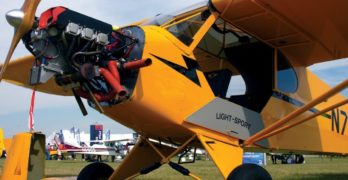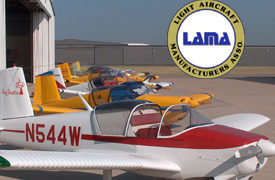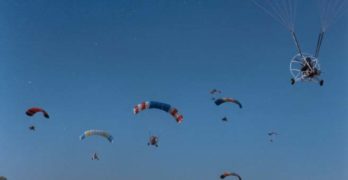A Review of the Industry Consensus Standards Method
In the aviation world, the new light sport aircraft category is all the rage, with interest at aviation trade shows climbing off the charts. New aircraft certified using ASTM International industry consensus standards recently reached model number 50, with all approvals coming in less than two years, a record in aviation history worldwide.
Doing things correctly and quickly is not uncommon in the world of light sport aircraft. This is a highly entrepreneurial activity populated by get-it-done businessmen and women who are highly motivated to get their nascent industry off the ground – literally.
Welcome to Committee F37
ASTM International’s Committee F37 on Light Sport Aircraft is just five years old, yet it has produced, from scratch, specifications for design, performance, quality acceptance tests and safety monitoring for LSA. ASTM standards guide the preparation of pilot operating handbooks, maintenance manuals, and a system of service bulletins to advise consumers of maintenance needed to keep their aircraft in good operating condition.
Search Results for : MG 21
Not finding exactly what you expected? Try our advanced search option.
Select a manufacturer to go straight to all our content about that manufacturer.
Select an aircraft model to go straight to all our content about that model.
Soaring Concepts Powered Parachute Earns SLSA #59
Sometimes it seems like all the attention is focused on fixed wing Special Light-Sport Aircraft. This makes some sense as they represent the majority, about 80% of all types. Still, you can’t ignore weight shift trike producers and those working to achieve airworthiness for powered parachutes. After a slow start, we now have 6 trike models approved as SLSA (and I’m waiting for verification on 2 more) plus we have 5 powered parachute models. Sales of non-fixed wing aircraft account for more than 21% of all SLSA registered with FAA with powered parachutes representing a quarter of this one-fifth share. *** Soaring Concepts president Galen Geigley reported his fresh airworthiness certificate was granted October 3rd, becoming model number 59 to earn approval. The company was founded in 2000 and in 2006, their Sky Trek won Reserve Grand Champion from AirVenture judges. Priding themselves on a well equipped aircraft, the 2007 Sky Trek SLSA is available with “leather illusion seats that gives you the premium look of leather with UV protection.”
Six Chuter Powered Parachutes Joins the LSA Parade
As the deadline approaches for ultralights needing to convert to LSA, companies are recognizing the need to get products ready for the new age of light-sport. The latest: Six Chuter, one of the original producers of powered parachutes…but one that took their time hopping on the bandwagon. *** Director of Communications, Doug Maas (who also completed the production test flight), reports the company developed more than 1,000 pages of documentation to meet ASTM standards. The voluminous information came from creating a brand-new carriage with multiple configurations. Legend (which is SLSA #58) can be a single seater, tandem seater, or a somewhat rare side-by-side powered parachute (photo). This is a novel approach to certification and explains the delay for the company’s SLSA entry. Six Chuter said, “The Legend XT SSDC (Side-by-Side Dual Control) is our SLSA development model targeted for flight instructors and others who enjoy a side-by-side configuration.” Six Chuter will offer the XT SSDC and other models as either fully-built SLSA or as ELSA kits.
“Seal of Approval”…IndUS Audited Successfully
Some folks wonder about the new Statement of Compliance to ASTM standards. Is this a true certification system? FAA doesn’t do the certification, so how do we know it means anything? Good questions. A manufacturer certifies their airplane. A Designated Airworthiness Rep (DAR) examines it. Companies behind each approved SLSA (now 38 aircraft) must also do an annual internal audit. Now industry association LAMA has started promoting voluntary independent audits, to be certain a design has met and still meets ASTM standards. The first of these was performed and today LAMA was advised that IndUS Aviation, maker of the Thorp T-211 and Thorpedo, successfully completed the first external audit of a LSA builder. LAMA president Tom Gunnarson called IndUS, “an accredited company.” Such third-party audits — plus a proposed decal applied to every aircraft showing successful completion — is likely to win support from EAA, AOPA, insurance companies, FAA, and NTSB.
Long-Wing Cross Country Cruiser & Soaring Machine
One actually got approved last year, I’m told, but a new 2008 model Urban Air Lambada UFM 13 more recently received its airworthiness as our newest, and 57th, Special Light-Sport Aircraft (SLSA). This is the second aircraft to use the ASTM standards for Glider (see 8/6/07 SPLOG) but is the first motorglider. TST-14 is more properly a “powered sailplane,” a rather fine but clear distinction. Imported by Bostik Industries LLC, Lambada is part airplane and part sailplane. It glides an impressive 26:1 or 30:1 from a 42.65- or 49-foot wing setup (both are standard; you exchange wing tips). Yet using the 80-hp Rotax 912 it will also cruise at better than 100 mph for 800 nautical miles on 26.4 gallons of fuel in two wing tanks. Lambada is a carbon and glass fiber shoulder-wing design available in taildragger or tricycle gear. It also comes standard with a Magnum Ballistic Parachute system, folding prop, stainless steel exhaust, and tinted canopy for $93,500.
Where Are Newer LSA Stars Like SportCruiser?
Over a short evaluation period of 25 months we’ve seen fairly consistent results in the top ten of LSA producers based on FAA registrations (see 5/21/07 SPLOG). But that doesn’t tell the whole story. Take Czech Aircraft Works (CZAW) and their best seller, the $75,000 Sport Cruiser. U.S. marketing and sales manager Bob Anderson reported, “CZAW raised additional equity capital last summer to finance a massive expansion.” The company is now housed in a 120,000 square-foot facility. CZAW president, Chip Erwin said, “We have skilled engineers and modern equipment in place. Our production ramp-up is not a ‘future claim.’ We’re doing it right now.” Anderson said part of the investment bought nearly a million dollars of state-of-the-art CNC equipment for matched-hole technology parts. The American-owned, Czech-based company has been delivering over 100 airplanes and kits per year from a smaller factory. They’ve shipped more than 850 aircraft to date.
Tecnam Sierra — The Italian Job
Before Cessna announced its
light-sport aircraft (LSA) prototype,
the Wichita, Kansas-based
aircraft manufacturer investigated the
airplanes produced by Costruzioni
Aeronautiche Tecnam, aka Tecnam.
Cessna’s interest was likely stimulated
by Tecnam’s 50-year history of
aircraft manufacturing. The company
traces its roots to 1950 and the P48B
Astore. You may also be familiar with
its twin-engine Partenavia series of
aircraft that emerged in the 1970s.
The Pascale brothers founded
Costruzioni Aeronautiche Tecnam
just after World War II, but the company
was reorganized in 1986. Based
today in Casoria, Italy, Tecnam is a
large operation with 36,000 square
feet of facilities near the Naples Capodichino
airport.
A second facility is located
in Capua, where the final assembly
line is adjacent to
an airport where flight tests
are conducted. “Professor”
Luigi Pascale, the 82-yearold
patriarch of Tecnam,
remains the guiding light
of the company. He reportedly
still does all first flights of Tecnam
airplanes. The company’s design approach
is backed with the latest Catia
V5 software, wind tunnel tests, and
close associations with Italian aero
institutes and universities.
FK Lightplanes’ Feature-Laden Fk9 Mk IV
This airplane began life under
B&F Technik Vertriebs GmbH,
a name derived from partners
Dirk Breitkreuz and Peter Funk, who
started the commercial enterprise.
Now, Funk operates the company on
his own and has adopted the worldlier
and less cumbersome name Fk-
Leichtflugzeuge, its English translation
being Fk-Lightplanes. U.S.
distributor Tony Anderson named
his enterprise Fk-Lightplanes USA.
Based in Pembroke Pines, Florida,
Fk-Lightplanes USA calls North Perry
Airport home.
The Funk name is storied in European
light aircraft development,
with more than a dozen original designs
to its credit. Fk-Lightplanes today
produces three airplanes, each
quite different from the other: our
subject airplane this month-the
high-wing Fk9, the low-wing Fk14
Polaris, and a folding-wing biplane
called the Fk12 Comet. I’ve had the
pleasure of flying all three models,
but I think the Fk9 may prove most
popular with American LSA enthusiasts.
Though designed and refined in
Speyer, Germany, the Fk9 and its siblings
are now fabricated in Poland by
workers with decades of experience
building Soviet fighters and transports.
Sky Ranger Defines a New Niche
Listening to the aviation media drumbeat about Sport Pilot/Light-Sport Aircraft, you could be excused for thinking ultralights had “vanished” and that it now takes $55,000 to $95,000 to buy a light recreational aircraft. Fortunately, this just isn’t so.
We’re beginning to identify the emergence of a middle ground and the Sky Ranger is positioned in this space. According to my Sky Ranger check pilot Ryan Gross, our test plane could be supplied by Sky Ranger Aircraft Company for $40,000 in ready-to-fly form. While this is significantly more than the Sky Ranger 503 kit I flew four years ago, it is about half the cost of the average new 3-axis light-sport aircraft (LSA), though some models, like the Fantasy Air Allegro 2000, are only $15,000 more than the Sky Ranger.
Regardless of how the Sky Ranger Aircraft Company may elect to supply fully-built aircraft versus kits, the design of this airplane was optimized to be a quick and easily-built kit.
Powrachutes on the Prairie
Only three weeks earlier, our nation had endured wrenching emotion from the September 11 attacks. But life must go on.
So Powrachute of Columbus, Kansas, went on with its third annual Extravaganza. One look at the grounds promised that this was to be no ordinary company fly-in. Most of them resemble a family picnic; this one looked like an airshow.
For the 2001 Extravaganza, Powrachute reported an attendance of 5000 spectators. Greeting them in this year of uncertainty was a beautifully airbrushed bald eagle against an American flag backdrop. The art took up 15,600 square feet of the flying field.
Mass Launch
Extravaganza participants came from 29 states plus Canada, and they brought 215 aircraft. Much like the giant hot-air balloon fiesta in Albuquerque, New Mexico, the Powrachute gathering provided a great photo opportunity to capture the large and colorful wings of aviation’s newest segment.
On one occasion during the four-day event, a launch of powered parachutes put 80 of them in the air in 20 minutes.
- « Previous Page
- 1
- …
- 81
- 82
- 83
- 84
- 85
- …
- 94
- Next Page »











